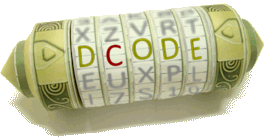Tool for detecting and correcting errors in binary message transmissions via Hamming corrective codes.
Hamming Error-Correcting Code - dCode
Tag(s) : Informatics
dCode is free and its tools are a valuable help in games, maths, geocaching, puzzles and problems to solve every day!
A suggestion ? a feedback ? a bug ? an idea ? Write to dCode!
Hamming Error-Correcting Code
Hamming Code Error Corrector
Hamming Encoder
Answers to Questions (FAQ)
What is a Hamming Code? (Definition)
Hamming codes are a series of codes / algorithms used to automatically correct binary messages if a corrupted / erroneous bit (0 or 1) is transmitted. The correction is done through minimal data redundancy which is useful for correcting transmission errors in digital communications.
How does Hamming Code work?
The algorithm proposed by Richard Hamming takes a binary message (composed of bits 0 and 1) accompanied by a few additional bits encoding information on the number and position of 1 bits in the message.
Example: The Hamming code 7,4 proposes to transmit 4 bits of data, via a 7-bit message, therefore comprising 3 redundant bits. Hamming code 255,247 only uses 8 redundant bits (3% size increase)
The extra bits encode the parity of a series of bits of the original message. Parity is the process of calculating whether the number of bits at 1 is even or odd.
The series of bits of the original message are selected so as to crisscross the entire message.
The first additional bit counts the parity of the bits in positions 1,3,5,7,9,11,13,… it is stored in position 1
The second additional bit counts the parity of the bits in positions 2,3,6,7,10,11,14,15,… it is stored in position 2
The third additional bit counts the parity of the bits in positions 4,5,6,7,12,13,14,15… it is stored in position 4
By crossing the information of these bits, it is possible to find the position of the error.
Example: In a 7.4 Hamming code, the second bit detects an error: it indicates that the message should have an even parity of the bits in positions 2,3,6,7 but this is not the case. The other bits do not indicate an error, so there is no problem with the bits in position 1,3,5,7 and 4,5,6,7 so the error is in position 2. Replacing the value of bit 2 (putting a 1 instead of a 0 or vice versa) corrects the error.
The Hamming code only makes it possible to detect a single alteration in the message, a single change of 1 or 0.
Example: The message 1100 (original) is coded as 0111100, the original message being coded on bits ..1.100, the first bit remains to be calculated (in position 1) which indicates the number of 1 (modulo 2) among positions 3,5,7 or 0 (because 2 = 0 modulo 2), then the second bit (in position 2) indicating the number of 1 (modulo 2) among positions 3,6, 7 is 1 and the third bit (position 4) indicating the number of 1 (modulo 2) among the positions 5,6,7 or 1. The message encoded by Hamming 7.4 is therefore 0111100.
How does Hamming Extended Code work?
In computer science, it is practical to use series of 8 bits (2 ^ 3), but Hamming codes are practical for messages encoded on 2 ^ n-1 bits. Adding an extra bit improves data redundancy at low cost of memory space.
The last bit added records the parity of the entire message, it is usually stored in position 1.
How to decode using Hamming code?
Difficult to speak of decoding strictly speaking, but rather of error correction in a received code.
— Calculate extra bits (sometimes called vector).
— Find the position of the error in the code word according to the values of the vector.
— Correct the error: invert the bit at the corresponding position.
How to recognize a Hamming Code ciphertext?
The message is binary, usually encoded with blocks of 2^n-1 or 2^n bits.
Any notion of error, alteration, erroneous information, etc. is a clue.
What are the limitations of the Hamming Corrector Code?
The Hamming Correcting Code can detect and correct a limited number of transmission errors. If there are too many errors, the code will not be able to correct them and the transmission will be considered a failure.
Source code
dCode retains ownership of the "Hamming Error-Correcting Code" source code. Any algorithm for the "Hamming Error-Correcting Code" algorithm, applet or snippet or script (converter, solver, encryption / decryption, encoding / decoding, ciphering / deciphering, breaker, translator), or any "Hamming Error-Correcting Code" functions (calculate, convert, solve, decrypt / encrypt, decipher / cipher, decode / encode, translate) written in any informatic language (Python, Java, PHP, C#, Javascript, Matlab, etc.) or any database download or API access for "Hamming Error-Correcting Code" or any other element are not public (except explicit open source licence like Creative Commons). Same with the download for offline use on PC, mobile, tablet, iPhone or Android app.
Reminder: dCode is an educational and teaching resource, accessible online for free and for everyone.
Cite dCode
The content of the page "Hamming Error-Correcting Code" and its results may be freely copied and reused, including for commercial purposes, provided that dCode.fr is cited as the source.
Exporting the results is free and can be done simply by clicking on the export icons ⤓ (.csv or .txt format) or ⧉ (copy and paste).
To cite dCode.fr on another website, use the link:
In a scientific article or book, the recommended bibliographic citation is: Hamming Error-Correcting Code on dCode.fr [online website], retrieved on 2025-04-11,
